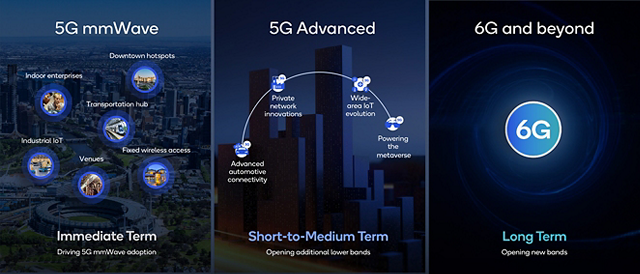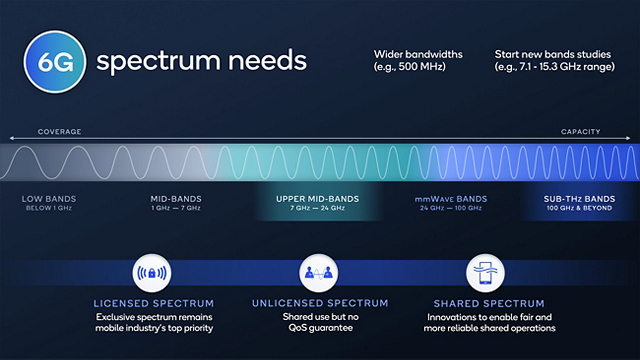Courtesy : Qualcomm
Spectrum is the backbone that carries all voice and data in wireless communications. It is a finite resource needed to connect virtually everything around us — smartphones, cars, laptops and the Internet of Things (IoT). However, available spectrum suitable for wide-area communications is becoming increasingly scarce as wireless data consumption continues to grow exponentially. That is why the continued allocation of new spectrum and efficient management of existing spectrum used for mobile terrestrial services remain our top priorities.
Today, 5G is being commercially deployed at scale across low, mid and millimeter wave (mmWave) spectrum bands. As we look towards the future, we are working with the entire wireless ecosystem to open new mobile spectrum bands globally to support wireless growth. While it is important to continue driving new efficiencies in existing bands, by improving multiple-input, multiple-output (MIMO) performance and exploring better sharing techniques, we need to identify and allocate new spectrum bands and commercialize innovations that can make these bands suitable for mobile operations and new use cases.
Global 5G spectrum updates and innovations for future wireless systems

Expanding mmWave footprint and opening new mid-band spectrum
As data demands continue to soar, 5G mmWave can complement 5G sub-7 gigahertz (GHz) deployments to offer ultra-fast speeds, low latencies and enhanced user experiences in areas that need additional capacity, such as urban centers and dense venues.
Looking at the short-to-medium timeframe, our focus shifts towards opening additional sub-7 GHz bands (e.g., more bands for 5G in the 3 to 5 GHz range), which can fuel the growth of wide-area 5G use cases. The World Radiocommunication Conference 2023 (WRC-23), scheduled for November this year, will bring together administrations worldwide to address spectrum needs, including those for 5G Advanced and 6G.
Paving the path to a new level of efficiency with advanced spectrum sharing
Spectrum sharing is a key innovation that enables not only different mobile technology generations to coexist in the same band, but also different technologies, such as satellite and mobile. Qualcomm is leading the charge in developing advanced spectrum sharing technologies, aiming for optimized use of limited spectrum resources. This includes facilitating efficient use even among different operators in licensed bands, as demonstrated by our advanced 5G mmWave spectrum sharing demo.
Taking it a step further, a promising application of the spectrum sharing concept is to take it into the Open Radio Access Network (O-RAN) domain. O-RAN is a disaggregated, open radio access network architecture allowing greater flexibility and interoperability between different network components. O-RAN open fronthaul could be the basis for multiple operators to not only share the same infrastructure (e.g., radio units or RU), but also share spectrum, dynamically allocating resources based on real-time demand, and improving overall utilization. Inherently, O-RAN enables a competitive ecosystem of network equipment vendors, which can foster innovation and drive down costs for mobile operators.

Setting the stage for 6G
Each new wireless generation requires additional spectrum to enable major technological improvements from the previous generation. Often, these advancements are made possible due to the availability of wider, contiguous spectrum bandwidths. For example, with 5G, bandwidths increased from 20 megahertz (MHz) to 100 MHz. We anticipate that 6G requires contiguous channels of at least 500 MHz to meet future use cases.
Identifying new spectrum bands notpreviously used for mobile terrestrial operations is challenging because of incumbent operations. It will require technical studies looking into the co-existence and compatibility with incumbent services as soon as possible. The studies will allow for the identification of bands where mobile terrestrial service can operate, which is essential to ensuring we can standardize the enabling technologies and drive timely commercial deployment at scale.
The frequency range of 7 GHz to 24 GHz — with a particular focus on the 7 GHz to 16 GHz range (called upper mid-band) — has been widely identified for 6G consideration. The 7 GHz to 16 GHz frequency range can support wide-area coverage as well as high capacity, especially with the new technological advances of 6G.
Qualcomm is developing advanced end-to-end system innovations called Giga-MIMO, which utilize a large number of antennas on both the base station and device to support wide-area communications in the upper mid-band. Our studies, so far, show that the coverage is comparable to what can be achieved with 5G massive MIMO today in the lower mid-band frequency bands. Earlier this year, we showcased our Giga-MIMO system enabling wide-area coverage in 7 GHz to 16 GHz at Mobile World Congress (MWC23).









